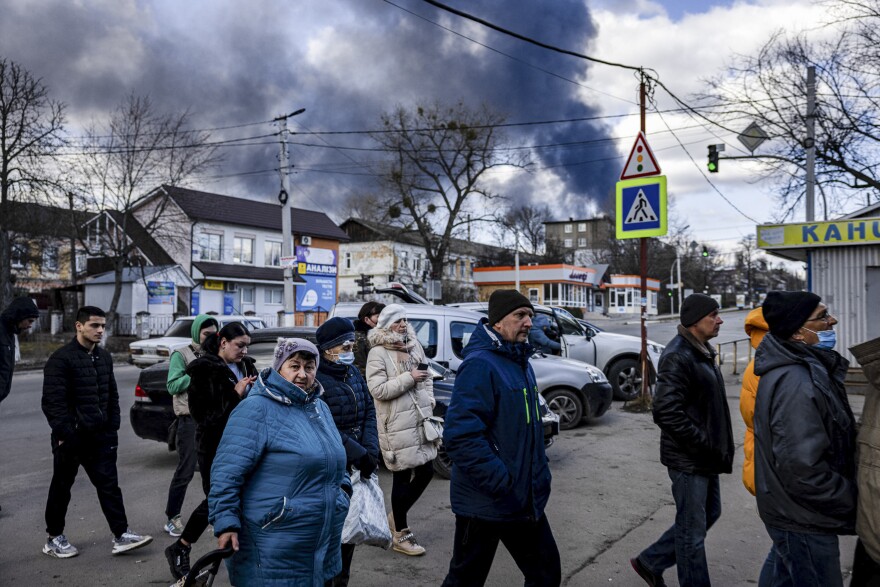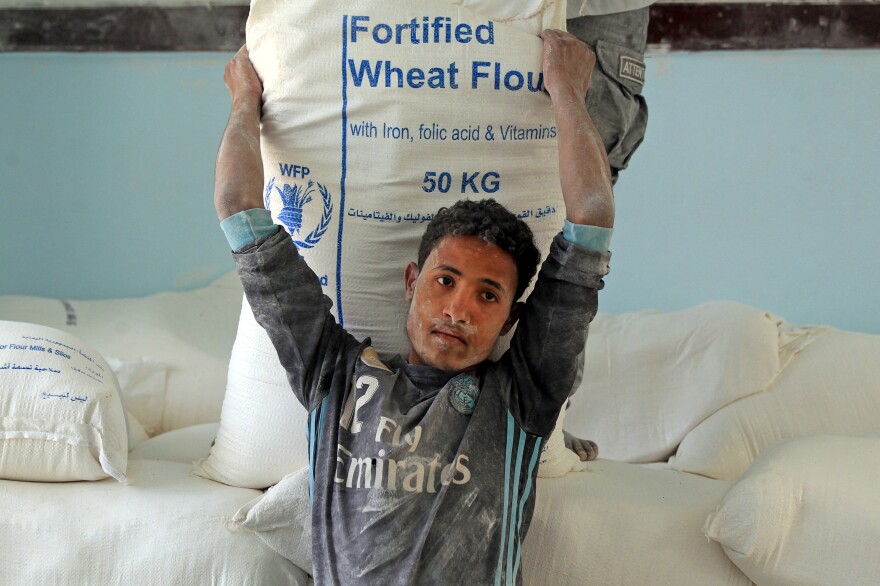Russia's invasion of Ukraine isn't only jeopardizing the lives of Ukraine's citizens. The war is also on track to cause a surge in severe malnutrition and even starvation around the world.
That's the grim assessment of many experts on global food security, who point to how heavily the rest of the world relies on Ukraine and Russia for wheat and a slew of other essential commodities. As that supply is cut off, it will drive up food prices that are already at record levels – and at a time when the economic fallout from the pandemic has already pinched household budgets, most devastatingly in low-income countries.
"Frankly I'm extremely worried," says Arif Husain, chief economist at the World Food Programme. "People in Ukraine are in a disastrous situation and they're fighting for their lives. But this disaster is beyond borders. It is also going to hurt people thousands of miles away."
To find out just how bad things could get, NPR spoke to Husain, as well as to another prominent analyst, Joseph Glauber, a senior research fellow of the International Food Policy Research Institute, or IFPR. Both Glauber and Husain laid out some alarming scenarios. But they also pointed to concrete actions the world could take to ensure the worst does not come to pass. Here are six takeaways:
1) The timing challenge
While a military conflict in Ukraine was always going to have some impact on the world's food supply, WFP's Husain says, "the timing of this unnecessary, unwanted, unjustified war couldn't have been worse."
Take the cost of food. Over the last year the prices of key commodities have jumped to their highest levels since the spikes of 2008 through 2012. Back then the strain prompted people around the world to erupt in civil unrest – particularly in the hard-hit Middle East and Northern Africa, notes IFPRI's Glauber.

He says the causes of this current price crunch are manifold. But much of it has to do with reduced supply. Droughts have cut into recent harvests for wheat in North America and for soybean and corn in South America. Typhoons in Malaysia last year shrunk the crop of palm oil used for cooking, among other purposes. The upshot, says Glauber, is that, "it's not like [the war in Ukraine] is coming as we're flush with grain reserves and other things. Prices have been high. This is going to send them higher."
The human cost has also been mounting. "After decades of seeing the percent of the population that is malnourished in the world decline, over the last four or five years we've actually seen rising percentages," says Glauber. Husain notes that currently about 276 million people worldwide are in the midst of a hunger crisis – with 44 million of them "one step away from famine. If we cannot assist them they will die. It's that simple."
Then there's the impact of the pandemic. "I think probably the worst thing is that this is coming during the time of COVID," says Husain. "A lot of people in many parts of the world have lost their jobs. They don't have the incomes. They don't have the purchasing power. Now on top of that, they've been dealing with inflation. So you're getting squeezed from both sides."
Many governments too, are less economically resilient now after two years of dipping into their coffers to soften COVID's economic blow on their citizens, adds Husain. "People are tapped out. And governments are tapped out."
2) A long list of affected products
In recent years Ukraine and Russia have both become "a major engine" for feeding the world, says Glauber. In an analysis, he and some colleagues found that the various agricultural products exported by the two countries account for about 12% of the calories the world trades.
Much of this is through wheat. Ukraine alone accounts for more than 10% of the global market, says Glauber. Add in Russia and the share jumps to more than 30%.
But it doesn't end there. The two countries are also a major source of grains such as corn and barley that are mainly fed to livestock. Ukraine provides about 15% of the global supply of corn, for instance. And taken together Ukraine and Russia account for just under 30% of the world's barley supply.
Another important product is sunflower oil, one of the main vegetable oils used for cooking. The two countries contribute about 80% of the world's supply.
Russia — along with Belarus — is also a huge source of fertilizer, providing about 15% of the world's needs.

Then there's the crucial stream of oil and gas exported from Russia via Ukraine. While technically these fuels don't count as food, their impact on food prices is enormous, says Husain: "When the price of gas goes up, everything goes up."
3) Multiple paths to disaster
There's a range of reasons why the supply of all these commodities could dry up.
The most obvious risk is to Ukraine's exports. "The good news," says Glauber, is that at present most of the wheat from Ukraine's last harvest has already been shipped out of the country. Still, he says, about 30% still awaits transport. That's also the case with about 45% of the corn crop. "Now the ports are shut," he says. So a key question is how long that will remain the case.
Another test will come in April, when planting for corn, barley and sunflower seed should begin – much of it in areas where Russia's military is currently bearing down. This summer will be another crucial period. That's when the next major wheat harvest would need to take place.
Russia's planting and harvesting doesn't face the same disruptions as Ukraine's. And sanctions are not currently directly targeting Russia's food exports. Yet the war could still cause major disruption.
Husain notes that two major shipping lines have already refused to do business with Russia. "If you're tainted, nobody's going to do business with you, even if it is allowed," he says. And when even just one component in the export process gets affected the ramification can be enormous. "The supply chain network is so complicated that if somebody sneezes in one place, somebody else gets the cold in another place," says Husain.

4) A long list of countries at risk
In the immediate term it would seem that the countries most likely to be affected by a cut-off in exports from Ukraine and Russia are those that currently get a large share of their imports from the two countries. For instance, in their analysis Glauber and his co-authors found that Egypt is one of several countries that get more than about half of their imported calories from Ukraine and Russia. Other heavily reliant countries of concern to food security experts include Cameroon, Democratic Republic of Congo, Libya, Nigeria, South Sudan, Sudan and Yemen.
But Glauber and Husain both stress that because world commodity markets are so interconnected, it won't take long for prices to rise even in countries that don't currently source their wheat, corn or other commodities directly from Ukraine or Russia. "Any disruption that happens in one place has an effect in another place," says Husain.

Another way to gauge where the fallout will be most severe is to look to countries that are heavily reliant on one of the products at risk – regardless of where they're currently getting it from. Glauber says he worries about Bangladesh, for instance, because it is heavily reliant on fertilizers – and because its government has already had to stretch itself to subsidize farmers hurt by the current rise in prices.
Husain, too, says that since every country is likely to feel the stress, he's most concerned about those that are "already in trouble" when it comes to food crises. Unfortunately, he adds, "that's a big list. I mean there are 38 countries where there are people facing emergency levels of hunger."
5) Throwing money at the problem ... would work
As depressing as all this may sound, Glauber and Husain both point to a bright spot: Even with the loss of the contributions to the food supply from Ukraine and Russia, there would still technically be enough quantity left to feed the world. In other words, the only problem will be the increased price of that food. This in turn, suggests that the immediate solution will be monetary. As Glauber puts it, "someone has to pay for those higher costs." So if governments and other donors can fill the gap between what people are able to pay and the new, higher price of food, people will not go hungry.

6) The world's track record on funding is abysmal
Unfortunately, says Husain, the world has not been particularly generous even in better times. Just before Russia's invasion of Ukraine, the World Food Programme – which is the main arm of the United Nations responsible for averting hunger crises – was attempting to raise enough money to assist about 140 million people worldwide in 2022. That would require about $18 billion, says Husain. To date he says, member states have provided about 50% of that. And that's not even considering the $580 million that WFP will now be asking countries to contribute to help about 3.2 million Ukrainians inside the country and an additional 200,000 refugees who the United Nations estimates will now need food aid over the next six months.
"This is our world in the 21st century," he says.
Copyright 2023 NPR. To see more, visit https://www.npr.org.




